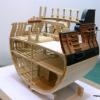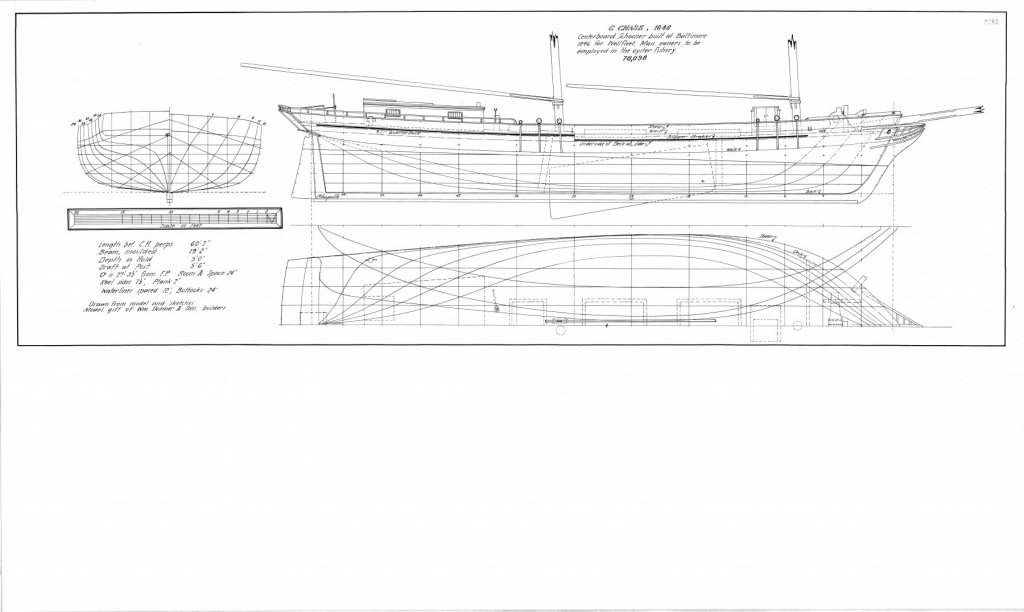-
Posts
1,490 -
Joined
-
Last visited
Content Type
Profiles
Forums
Gallery
Events
Everything posted by Maury S
-
I'm lofting (using TurboCad 2018) a new set of plans based on Chapelle's drawings. It's a long process and several episodes of throwing away work because I did something wrong. I've made a contact at the Wellfleet Historical Society who said he would look into any info. he could find on the boat. Randy Biddle has been quite helpful in finding obscure drawings, construction methods, etc. Nothing special to show with a picture yet. Maury
-
The anchor looks great from here. Sorry about the comment on the bend! Maury
- 1,449 replies
-
Toni, Looking great! Looking better and better. The middle stanchion in the photo looks like it has a more rounded bend than the others. I'm surprised that a plate was not called for at the bottom of the stanchions. (Picky, I know, but I miss little details all the time and appreciate it when fresh eyes point them out.) Maury
- 1,449 replies
-
Mark, In that era, I think speed was becoming much more important in getting fresh goods to market. Look at Chapelle's "Search for Speed Under Sail". See Ed Tosti's Young America log. Those boats were built with little regard for capacity. After building the Anchor Hoy with it's bulbous bow, I'm really looking forward to doing this. I think Spray was a smaller sloop albeit involved in the oyster trade. Maury
-
This has got to be the most detailed model of this scale ever made! Incredible. Maury
- 3,618 replies
-
- young america
- clipper
-
(and 1 more)
Tagged with:
-
The Centerboard fishing schooner C. Chase was built about 1846 by Willliam Skinner & Sons for Wellfleet, Mass. owners. From the National Watercraft Collection by Howard Chapelle: "It represents a type much favored in the Chesapeake oyster fishery...Some were shoal-draft keel vessels of the pungy type, others were centerboarders like the C. Chase, but all had sharp lines and were designed for speed...Their centerboards, and the mast as well, were usually off the centerline of the hull to bring the board far enough aft to give the proper balance to the rig used. They carried large sail areas and lofty masts. At about the time this schooner was built, the longhead began to replace the "naval head" in the Chesapeake." If anyone an explain the longhead vs the "Naval head", I'd appreciate it. The lines were taken from a Builders Half-Model in the U.S. National Museum [USNM 76098] and presented in the book and offered by the Smithsonian. Length between perpendiculars: 60 '- 7" Moulded beam: 19' - 2" Depth of hold: 5' If anyone has more information about the size of the "lofty masts", please let me know. I have recently seen an old photo of a similar boat with REALLY tall masts. Maury
-
Ed, Drilling all the holes in the spar while still square certainly helps. Thanks for that tip earlier. Maury
- 3,618 replies
-
- young america
- clipper
-
(and 1 more)
Tagged with:
-

Acrylic colours for artists
Maury S replied to TomJonas's topic in Painting, finishing and weathering products and techniques
Another area of expertise... military miniatures . Maury -
Such very clean joints! Maury
- 607 replies
-
- winchelsea
- Syren Ship Model Company
-
(and 1 more)
Tagged with:
-
Ed, I think this is the most complex (and complete) rigging on a model I've ever seen. Kudos for even attempting such a challenge, and don't expect me to follow you down that hole. Maury
- 3,618 replies
-
- young america
- clipper
-
(and 1 more)
Tagged with:
-
Druxey & Mike, I like merchant ships. American, 1750 -1850 + /-, approx. 50 - 60 feet long. I don't see anyone doing anything with a centerboard and the mechanism to raise and lower it would be interesting. Before doing the hoy, I searched out some Granite sloops. Plenty of info. on the Albert Baldwin but she was about 90'...too big for my avail. space and preferred scale. If anyone knows of something that fits, PLEASE let me know. Maury
- 525 replies
-
- anchor hoy
- hoy
-
(and 1 more)
Tagged with:
-
Thanks all, A display case seems to be an issue with some. I believe the glass (if you use glass) is the biggest issue and the biggest cost. The case as shown cost about $45 in materials and $250 for the glass. All told, it took a week to build (mostly waiting on glue and stain to dry). After spending 2 + years doing a model, protect and display it properly. Maury
- 525 replies
-
- anchor hoy
- hoy
-
(and 1 more)
Tagged with:
-
Mostly finished. A few more attempts at laying down the anchor cables and anything else anyone sees in the pictures that I may have missed... Thanks for all the support and comments along the way. Maury
- 525 replies
-
- anchor hoy
- hoy
-
(and 1 more)
Tagged with:
-
Druxey, The frame is pine. The base is maple (plywood). I tipped over the can of ebony stain into the base, so it will have to be very dark / black. Latest plan is a piece of maple (3'/4" x 5" x 19"). It will support the made pedestals which will raise the boat about 1 1/4" giving room for the large anchor to hang freely. All will sit within the display case. The 5 pieces of "Museum Glass" cost about $250 with the various discounts offered by Hobby Lobby. The glass assures no reflective glare and almost total UV protection. A few more manipulations of the anchor cables and minor dust removal and it's done. Maury
- 525 replies
-
- anchor hoy
- hoy
-
(and 1 more)
Tagged with:
-
Toni, So you are just using the Sculpty for a prototype and then replicate it in wood? Maury
- 1,449 replies
-
When I'm not coiling lines, I'm working on the case. Off to buy the "Museum Glass" now that I've got the final dimensions. Maury
- 525 replies
-
- anchor hoy
- hoy
-
(and 1 more)
Tagged with:
-

Black wire for eye bolts/rings
Maury S replied to Johnnyreg's topic in Metal Work, Soldering and Metal Fittings
John, I think the "Artistic" brand wire is coated. You have to remove the coating before any attempt at blackening. Steel wool and a bath of Acetone usually works. (Be very careful with acetone...quite volatile). Maury -
I started working on the display case for my Anchor Hoy. (The garage needed cleaning anyhow). This is the third case I've made using Wes Marden's "Build You Own Model Ship Case". The base is shown below. You will need a table saw and a miter box or"Chop box" shown in Pic. 2 below. I don't want to show too much detail (protecting his methods). You can buy his booklet at www.modelshipcases.com for about $12. I will touch up the vertical posts on the router and make it a bit more sophisticated and it's a good case design for a modest amount of money. The "Museum Glass" will cost 5x the wood. Maury
-
Toni, Glad to see you back. I have enough trouble bumping into the rigging while working. I can't imagine the frustration of actually falling on the model. Considering mass and velocity at scale, she held up remarkably well. Best. Maury
- 1,449 replies
-
Thanks. I made up a few coils using a simple jig with different lengths between pins, dowsing them with Mat Medium and hanging them on the pins on the mast pinrail. Certainly better than round loops. Maury
- 525 replies
-
- anchor hoy
- hoy
-
(and 1 more)
Tagged with:
-
Cleating off the three jib tacks and halliards. The boom downhaul is also tied off the the mast rail. It is a challenge to get in there without knocking something else. Doing proper cleat hitches is no easy task either. After a dab of dilute glue (PVA) the tails are cut to about 1 - 2" which is starting to clear up the deck for the rest of the rigging. Maury
- 525 replies
-
- anchor hoy
- hoy
-
(and 1 more)
Tagged with:
About us
Modelshipworld - Advancing Ship Modeling through Research
SSL Secured
Your security is important for us so this Website is SSL-Secured
NRG Mailing Address
Nautical Research Guild
237 South Lincoln Street
Westmont IL, 60559-1917
Model Ship World ® and the MSW logo are Registered Trademarks, and belong to the Nautical Research Guild (United States Patent and Trademark Office: No. 6,929,264 & No. 6,929,274, registered Dec. 20, 2022)
Helpful Links
About the NRG
If you enjoy building ship models that are historically accurate as well as beautiful, then The Nautical Research Guild (NRG) is just right for you.
The Guild is a non-profit educational organization whose mission is to “Advance Ship Modeling Through Research”. We provide support to our members in their efforts to raise the quality of their model ships.
The Nautical Research Guild has published our world-renowned quarterly magazine, The Nautical Research Journal, since 1955. The pages of the Journal are full of articles by accomplished ship modelers who show you how they create those exquisite details on their models, and by maritime historians who show you the correct details to build. The Journal is available in both print and digital editions. Go to the NRG web site (www.thenrg.org) to download a complimentary digital copy of the Journal. The NRG also publishes plan sets, books and compilations of back issues of the Journal and the former Ships in Scale and Model Ship Builder magazines.


